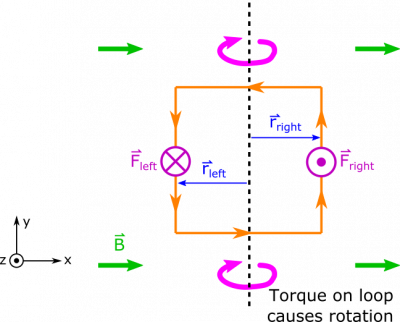This is an old revision of the document!
Review of Flux through a Loop
Suppose you have a magnetic field $\vec{B} = 0.6 \text{ mT } \hat{x}$. Three identical square loops with side lengths $L = 0.5 \text{ m}$ are situated as shown below. The perspective shows a side view of the square loops, so they appear very thin even though they are squares when viewed face on.
Facts
- The orientations of the square loops are as indicated above. They can be described by their angles with respect to the magnetic field. $\theta_1 = 0$, $\theta_2 = 90^\text{o}$, $\theta_3 = 42^\text{o}$.
- The magnetic field is $\vec{B} = 0.6 \text{ mT } \hat{x}$.
- The length of a square's side is $L = 0.5 \text{ m}$.
Lacking
- The magnetic flux through each loop.
Approximations & Assumptions
- The loops have flat faces.
- The magnetic field does not change with time, and is uniform in space.
Representations
- We represent magnetic flux through an area as
$$\Phi_B = \int \vec{B} \bullet \text{d}\vec{A}$$
- We represent the situation with the given representation in the example statement above.
Solution
In order to break down our approach into manageable chunks, we split up the loop into its four sides, and proceed. It is easy to find the magnitude of the force on each side, since $\theta$ for each side is just the angle between the magnetic field and the directed current.
This gives the following magnitudes:
\[ \left| \vec{F} \right| = \begin{cases} IBL\sin \pi = 0 & \text{top} \\ IBL\sin 0 = 0 & \text{bottom} \\ IBL\sin \frac{\pi}{2} = IBL & \text{left} \\ IBL\sin \frac{\pi}{2} = IBL & \text{right} \\ \end{cases} \]
It remains to find the direction of the force, for which we will use the Right Hand Rule. You should be able to convince yourself based on the coordinates we have chosen that the force on the left side is in the $+\hat{z}$ direction, and the force on the right side is in the $-\hat{z}$ direction.
This means that the net force on the loop is $0$, the loop's center of mass won't move! However, the opposing forces on opposite sides will cause the loop to spin – there is a torque! The calculation for the torque is shown below, with a diagram included to show visually what happens.
The calculation is here:
$$\vec{\tau} = \vec{r} \times \vec{F} = \vec{r}_\text{left} \times \vec{F}_\text{left} + \vec{r}_\text{right} \times \vec{F}_\text{right} = \left(-\frac{L}{2} \hat{x}\right) \times \left(IBL \hat{z}\right) + \left(\frac{L}{2} \hat{x}\right) \times \left(-IBL \hat{z}\right) = IBL^2 \hat{y}$$


